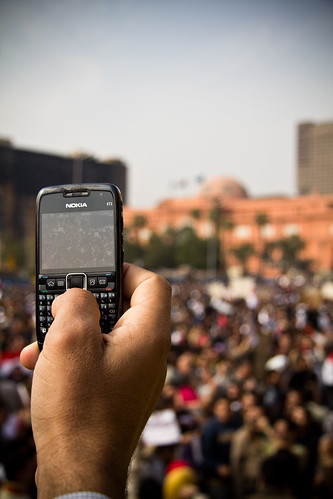
One of the most hotly debated topics surrounding the Arab Spring has been what role if any social media have played in the protests and, in a couple of cases, revolutions. Scholar Zaynep Tufekci (UNC) and The Engine Room’s Christopher Wilson have a new piece in Journal of Communication (gated) that looks specifically at the role of social media in Egypt’s Tarhir Square protests. The article appears in a special issue of the journal dedicated to the topic of social media and political change. They find evidence that Facebook in particular seemed to play a critical informational role, as well as mobilizing one. From the abstract:
We demonstrate that people learned about the protests primarily through interpersonal communication using Facebook, phone contact, or face-to-face conversation. Controlling for other factors, social media use greatly increased the odds that a respondent attended protests on the first day. Half of those surveyed produced and disseminated visuals from the demonstrations, mainly through Facebook.
The authors used a snowball sampling method – asking respondents to recommend others to participate in the survey – and ended up interviewing about 1,000 people who claimed to have participated in the Tahrir Square protests. The interviews were conducted about two weeks after Mubarak’s resignation. Tufekci and Wilson are upfront about the potential problems with their sample, to their credit.
There is much to chew on in the piece, but I’d like to flag a few things from the study:
- Face-to-face interpersonal communication was by far the most common way people first learned about the protests: 48.4 percent cited this as opposed to 28.3 percent that said “interpersonally oriented media” such as Facebook.
- That said, traditional media – in this case, satellite TV – was only cited by 4 percent of the respondents as the means by which they learned about the protests.
- A major function of new technologies ranging from social media to mobile phones (and both in tandem) was documenting events and spreading them virally.
- Women were heavier users of social media than men, and the differences were statistically significant.
Perhaps most interestingly, the authors make a case for thinking of a “new system of political communication” in the MENA region, one that isn’t just about “Facebook Revolutions” but instead sees a complex media ecology that has three, interrelated components:
- Satellite TV/traditional media
- Information and communication technologies (ICTs), especially social media platforms
- Ever cheaper and widely available mobile phones
The piece is an interesting addition to the growing body of scholarly literature in this area and worth checking out in full, as is the special issue.
